A Scion Society of The Baker Street Irregulars
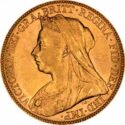
Coinage Portraits of a “Certain Gracious Lady”
“… it was a present from a certain gracious lady …”
– The Adventure of the Bruce-Partington Plans (BRUC)
There are numerous references to coins sprinkled throughout the sixty stories of the Canon. I find it helpful to visualize the design of the coins and the other items mentioned in the stories as I am reading.
Using William S. Baring-Gould’s The Annotated Sherlock Holmes as a reference, only 12 of the 60 stories occurred after the death of Queen Victoria in 1901. Most of the coins that Holmes was handling in the stories would bear her portrait, even after Edward VII coins started circulating in 1902.
There were three major portraits of Victoria on coinage during her 63-plus years reign. Several minor modifications occurred over the years, and we will discuss a few of these as well.
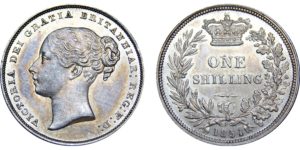
“Young Head” portrait by William Wyon on a Shilling
The bust of a young Victoria graced her coinage from 1839 until a new portrait was created for her golden jubilee in 1887. Holmes would have paid his Baker Street Irregulars with one of these in A Study in Scarlet. This portrait was the only one in use during this story and six others: “Gloria Scott,” “Musgrave Ritual,” “Speckled Band,” “Resident Patient,” “Noble Bachelor” and the “Second Stain.” This design was created by William Wyon, the Chief Engraver of the Royal Mint who in 1834 modeled the design of a then 15-year old Princess.
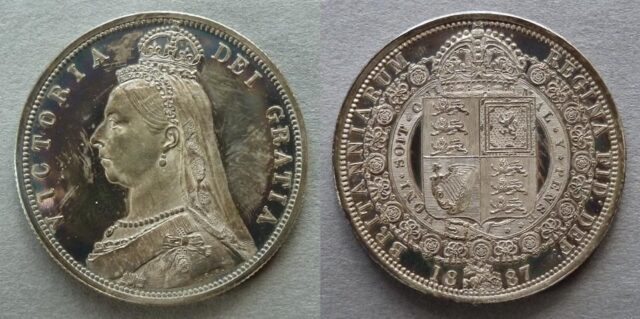
“Jubilee Head” portrait by Joseph Boehm on a Half Crown
For six years, beginning in 1887, the “Jubilee Head” of Victoria appeared on her gold and silver coinage. After ruling for 50 years and the British Empire having expanded to its largest size, a new portrait was needed to highlight the elegance of the older monarch and her accomplishments. Designed by sculptor Joseph Boehm, his initials appear below Victoria’s shoulder, and was the first to feature Victoria in her mourning veil. Public opinion was mixed on this design, as many believed that the design did not give the Queen the dignity she deserved with the crown precariously balancing on her head.
A few of this portrait might have been in the handful of half-crowns that Doctor Watson had in his pocket as Holmes was ranting about oysters in the “Dying Detective.”
The “Jubilee Head” design did not appear on any copper or bronze coinage of Queen Victoria. Wyon’s “Young Head” design was in use until 1860, when a new portrait was introduced as copper was replaced by bronze on the smaller denominations.

“Bun Head with wreath” portrait on a bronze Half Penny
In “The Man with the Twisted Lip,” the coat that Hugh Boone threw into the Thames had every pocket stuffed with pennies and halfpennies – four hundred and twenty-one pennies, and two hundred and seventy halfpennies. Most would have been the bronze coinage featuring Leonard Charles Wyon’s portrait of Victoria wearing a wreath. Some of the copper coins with his father’s “Young Head” design could have been among the many coins in the coat as well.
In “The Crooked Man,” Henry Wood’s had given his landlady what looked like a bad florin, but what was actually an Indian rupee. The florin, worth two shillings, is the only denomination issued during Victoria’s reign featuring what is known as her “Gothic portrait.” With her hair in braids and wearing a crown, the portrait gets its name from the lettering style used.

A British Florin (2 Shillings) with “Gothic” portrait, compare the portrait to the one on an Indian Rupee (below)
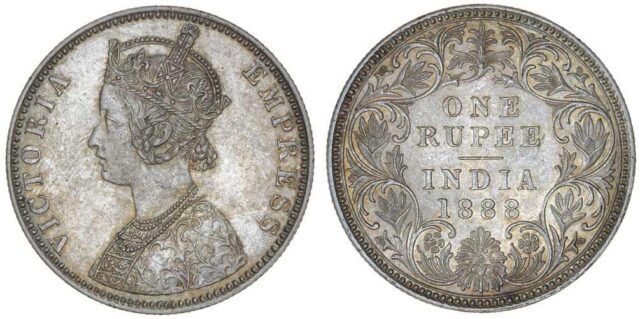
The portrait of Queen Victoria on the Indian rupee is similar to the portrait on the florin. With the limited number of florins in circulation, it is easy to understand the confusion if just looking at the portraits.
The last major portrait of Victoria was introduced in 1893 and is known as the “Old Head.” The design was created by Thomas Brock, who would later sculpt the Imperial Monument to Queen Victoria, which was erected in front of Buckingham Palace.
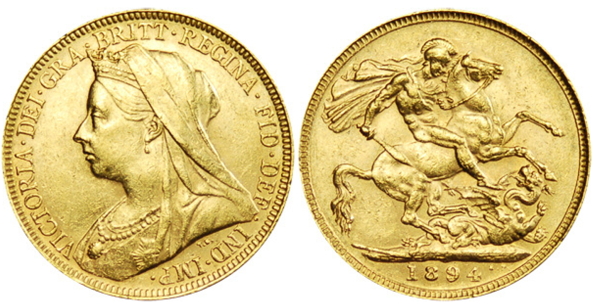
“Old Head” portrait on a Gold Sovereign
This design would have gone into circulation after “The Final Problem” took place and while Holmes was on his Great Hiatus. This portrait was used on all of her majesty’s coins – bronze, silver and gold.
This portrait of Victoria is one of the most famous images of her and is often used when dramatizing the stories for the big or small screen. An excellent illustration of this is from the first episode of the Granada series The Adventures of Sherlock Holmes.
In this episode, as in the actual story, Holmes is given a gold sovereign by Irene Adler. Watching the episode carefully, it can be clearly seen that the sovereign features the “Old Head” portraiture.
If we continue to use the dates established by Baring-Gould for chronology as 1887, they should have used either an “Young Head” or “Jubilee Head” coin,
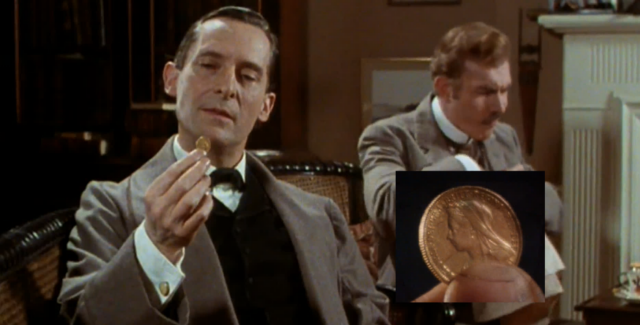
Jeremy Brett as Holmes holding an “Old Head” gold sovereign from the A Scandal in Bohemia episode of the Granada series
They used the wrong coin….
This post was originally published in the Summer 2019 issue of The Serpentne Muse, official publication of the Adventuresses of Sherlock Holmes

Sorry, comments are closed for this post.